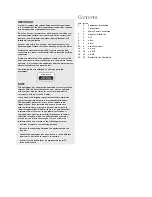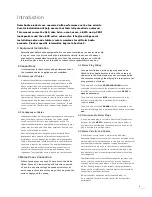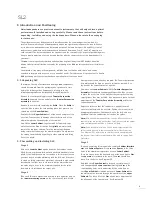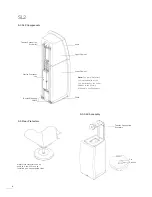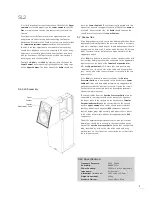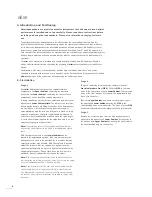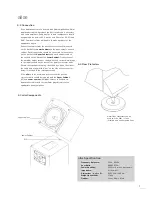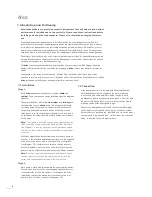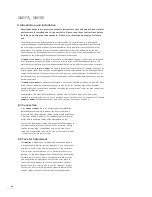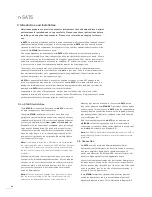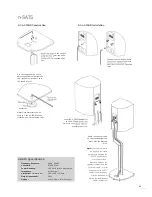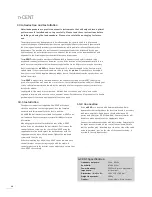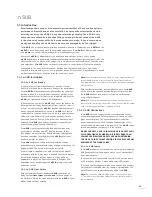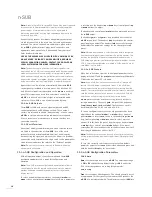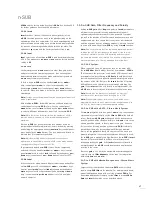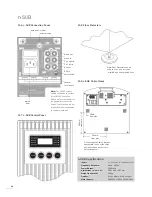
3
SL2
5 Introduction and Positioning
Naim loudspeakers are precision acoustic instruments that will only achieve optimal
performance if installed and set up carefully. Please read these instructions before
unpacking, installing and using the loudspeakers. Please also retain the packaging
for future use.
The performance of any loudspeaker will be influenced by the room and position in which it is
located. Even small changes of loudspeaker position can significantly influence the sound. Choose
a site where the loudspeakers can be located between 1.2m and 4m apart (4ft and 13ft), clear of
room corners, and where each loudspeaker is between 10cm and 45cm (4” and 18”) away from a
solid rear wall. The distance between the speakers and the rear wall is the aspect of positioning most
likely to require adjustment as you become familiar with the characteristics of the loudspeakers in
your room.
The
SL2
is not magnetically shielded and should be kept well away from CRT displays. Should a
display suffer picture distortion caused by the proximity of an
SL2
contact your dealer or installer for
advice.
Loudspeakers, like many hi-fi components, will take time to stabilise and “run-in” and can be
expected to improve with use even over a period of weeks. For this reason it is prudent not to finalise
SL2
positioning until the system has been operating for at least one week.
5.1 Unpacking SL2
To minimise the risk of accident and damage,
SL2
components
should be removed from the packaging one speaker at a time
and in the following order. Components referred to in the
following paragraphs can be identified through Diagram 5.3.
Remove the central packing piece and
Tweeter Suspension
Assembly.
Separate the two and place the
Tweeter Suspension
Assembly
to one side.
Remove the card shield containing the
Grille.
Place the
Grille
to
one side. Also remove the card packing piece that protects the
curved top of the
Upper Cabinet.
Carefully lift the
Upper Cabinet
out of the carton and place it to
one side. Take care not to damage either the drive unit or the
aluminium plate on the underside of the cabinet.
Now lift the
Lower Cabinet,
together with its foam end-caps
out of the carton. Stand it on the floor,
plinth
lowermost, and
remove the top foam end-cap. Turn the cabinet upside down
being careful not to damage the aluminium plate. Finally remove
the sprung foam end-cap by pulling its sides outward and lifting
it over the plinth.
5.2 Assembling and Installing SL2
Stage 1
With each
Lower Cabinet
upside down the floor spikes can be
fitted. Screw a spike and lock-nut into each threaded hole in the
plinth. If the loudspeakers are to stand on a thick carpet, leave a
generous length of spike protruding past the lock-nut. If they are
to stand on thinly carpeted or plain floor, the spike length should
be reduced. In either case, best results will be achieved when
the spike length is set to the minimum required for the spike
lock-nuts to sit just above the carpet pile.
Stage 2
Take each Tweeter Suspension Assembly in turn and offer it up to
the
Tweeter Mounting Points
on the rear of each Plinth. Attach
it using the bolts and allen key supplied. The Tweeter Suspension
Assembly should be fixed as close to vertical as possible. Use
the back of the Lower Cabinet as a guide.
Now move each
Lower Cabinet
with the
Tweeter Suspension
Assembly
attached into the appropriate position. Take care not
to place them so close to the wall that the rear spikes foul any
carpet gripper that may be fitted. Also leave some space for final
adjustment of the
Tweeter Suspension Assembly
and for the
connecting cables.
Adjust the spikes so that the cabinets are upright (a small
spirit level will help) and do not rock. Tighten the lock-nuts with
an appropriate spanner. Check again, once the lock-nuts are
tightened, that the cabinets do not rock on the spikes.
Note:
With thick carpet and underlay it can be difficult to ensure
that the spikes are resting on the floor. Small slits cut into the carpet
once the loudspeaker position is finalised will help.
Note:
If you intend to install the SL2 on a non-carpeted floor the
spikes should be used in conjunction with Naim Floor Protectors
(see Diagram 5.4) and set up so that just the tip extends beyond
the lock nut. Your retailer or distributor will be able to supply Floor
Protectors.
Stage 3
The pack containing this manual also contains
Cabinet Interface
Pins
and
Cabinet Spacers.
Fit a
Pin
and a
Spacer
to the three
holes in the aluminium top surface of each
Lower Cabinet.
There are two holes at the front and one at the back. Spare
Pins
and
Spacers
are included in the pack. The
Pins
should be a
loose fit in the holes. See Diagram 5.5
Now take each
Upper Cabinet
in turn and carefully lower it
onto the appropriate
Lower Cabinet
locating the
Pins
in the
corresponding holes on its underside. At the same time as
each
Upper Cabinet
is lowered onto each
Lower Cabinet,
the
tweeters must be inserted through the apertures of the
Upper
Cabinets.
The loose fit of the
Pins
allows some adjustment of
the alignment of the two cabinets. See Diagram 5.6


